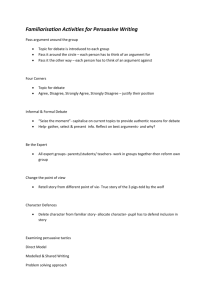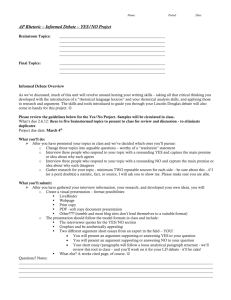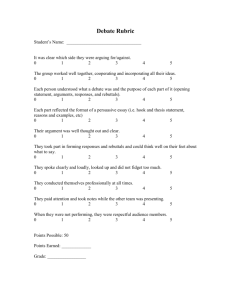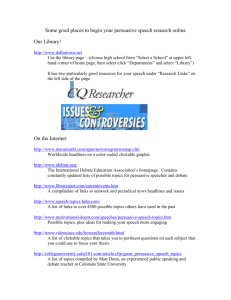Decisions, Decisions, Decision
advertisement
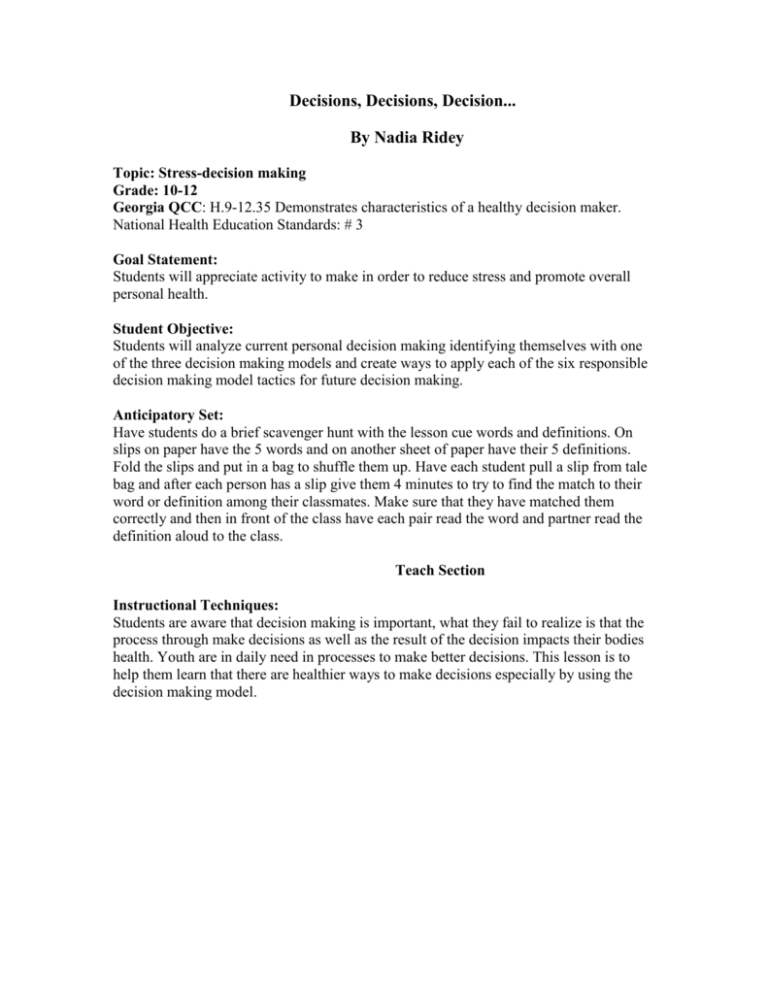
Decisions, Decisions, Decision... By Nadia Ridey Topic: Stress-decision making Grade: 10-12 Georgia QCC: H.9-12.35 Demonstrates characteristics of a healthy decision maker. National Health Education Standards: # 3 Goal Statement: Students will appreciate activity to make in order to reduce stress and promote overall personal health. Student Objective: Students will analyze current personal decision making identifying themselves with one of the three decision making models and create ways to apply each of the six responsible decision making model tactics for future decision making. Anticipatory Set: Have students do a brief scavenger hunt with the lesson cue words and definitions. On slips on paper have the 5 words and on another sheet of paper have their 5 definitions. Fold the slips and put in a bag to shuffle them up. Have each student pull a slip from tale bag and after each person has a slip give them 4 minutes to try to find the match to their word or definition among their classmates. Make sure that they have matched them correctly and then in front of the class have each pair read the word and partner read the definition aloud to the class. Teach Section Instructional Techniques: Students are aware that decision making is important, what they fail to realize is that the process through make decisions as well as the result of the decision impacts their bodies health. Youth are in daily need in processes to make better decisions. This lesson is to help them learn that there are healthier ways to make decisions especially by using the decision making model. Lesson Cues: 1. Inactive Decision Making: A decision making style in which a person fails to make a choice. 2. Proactive Decision Making: A decision making style in which a person examines the decision to be made, identifies and evaluates action that can be taken, selects action and assumes responsibility f6r consequences. 3. Reactive Decision Making: A decision making style in which a person allows others to make decisions for them. 4. Decision Making Model: a series of steps to follow to make sure the decision the person makes leads to actions like: a. Promote health b. Promote safety c. Protect laws d. Show respect to self and others e. Follow guidelines set by responsible adults f. Demonstrates good character 5. Empowered: to be inspired because of the belief that a person has some control over the direction of his/her life. 6. Life Skills: Promote health literacy, maintain and improve health, prevent disease, and reduce health related risk behaviors. 7. Delayed Gratification: Allowing oneself to sacrifice the present so that a benefit will be achieved in the future. Teacher Modeling: The teacher will pass out worksheet with debate criteria and will give example by selecting one decision making style, stand in front of the class and briefly cover the first two questions but in the manner in which she/he would like the students to answer the questions stated in a persuasive tone. She will remind them to have each group member participate and also state that during the debate the more group members that speak the more persuasive they look. Teacher will also remind students that they are FOR the decision style that they were given for this activity, despite their actual opinion. Student Activity: Have students in groups of 3, have one person per group pull from a bag that has the three decision-making styles on folded slips of paper. After each group has selected, give them the handout that has the directions and question for the activity. Have them generate support for an informal debate. give them 12 minutes to organizes points. Have them work together within this time to develop a strong support FOR the decision style that they chose. each group is tying to prove why their decision style is the best. Within their debate strategies they must discuss the following points/answer the questions to support their opinions. 1. What is your decision-making style/what word best describe it? 2. How does it work in the best interest of a person? 3. How does it make you more responsible and promote overall health? 4. It follows the decision making model because it applies which of the 6 actions 5. When have you or someone you know used this decision making style? Closure: Students will write on a sheet of paper about a past situation in which they made a stressful decision. Based on the 3 types of decision making styles we learned today, which one did they categorize themselves as using and why do they think they chose this style. Evaluation: The papers will be collected from students they will be checked to see if. 1. Papers were completed 2. Which style did they use in the past3? Why they feel they used that style4. Did they select a stressful situation from the past? If all elements are present then full credit of 10 points will be issued for all missing parts one point will be deducted. Reteach: For this lesson I feel that the class atmosphere was pretty down and they did not seem excited about the material so, to make the debate more lively I would have the students work individually instead of paired and for each decision style have one student for it and the other student against the style and had any remaining students with out a side as a few questions to back up their argument. This would create a different setting and possibly create more interaction as well as excitement for the activity. Resources: *Insel, Paul M. & Walton T. Roth (1998). Core Concepts In Health: Eighth Edition Inactive Decision Making A decision making style in which a person fails to make choices, and this failure determines what will occur. Reactive Decision Making A decision making style in which a person allows others to make decisions for him/her. Proactive Decision Making A decision making style in which a person examines the decision to be made, identifies and evaluates action that can be taken, selects an action and assumes responsibilities for consequences. Delayed Gratification Allowing oneself to sacrifice the present so that a benefit will be achieved in the future. Life Skills Promote health literacy, maintain and improve health, prevent disease, and reduce health related risk behaviors. Empowered To be inspired because of the belief that a person has some control over the direction of his/her life. THE GREAT DEBATE Directions: Within your group you must all discuss the decision making style you selected and find reasons to support why your group feels that it is the best style to have. Your support must be a mixture of opinion and issues related to stress promotion or reduction issues. Your group must also answer (in a creative way) all of the 5 questions below within your debate argument. Try to be as persuasive as possible. Each group member must do something! Topic: The-3 Decision Making Styles Question to be discussed: Which One is the Best! Side Taken in Debate: You are FOR your style. Questions/points to be covered within your argument as follows: 1. What is your decision making style, what word best describes it? 2. How does it work in the best interest of a person? 3. How does it make you more responsible and promote overall health? 4. It follows the decision making model because it follows which of the 6 actions. 5. When have you or someone you know used this decision making style. HINT ***** The more each member talks to support your side the more strong your argument looks!!!! GOOD LUCK
